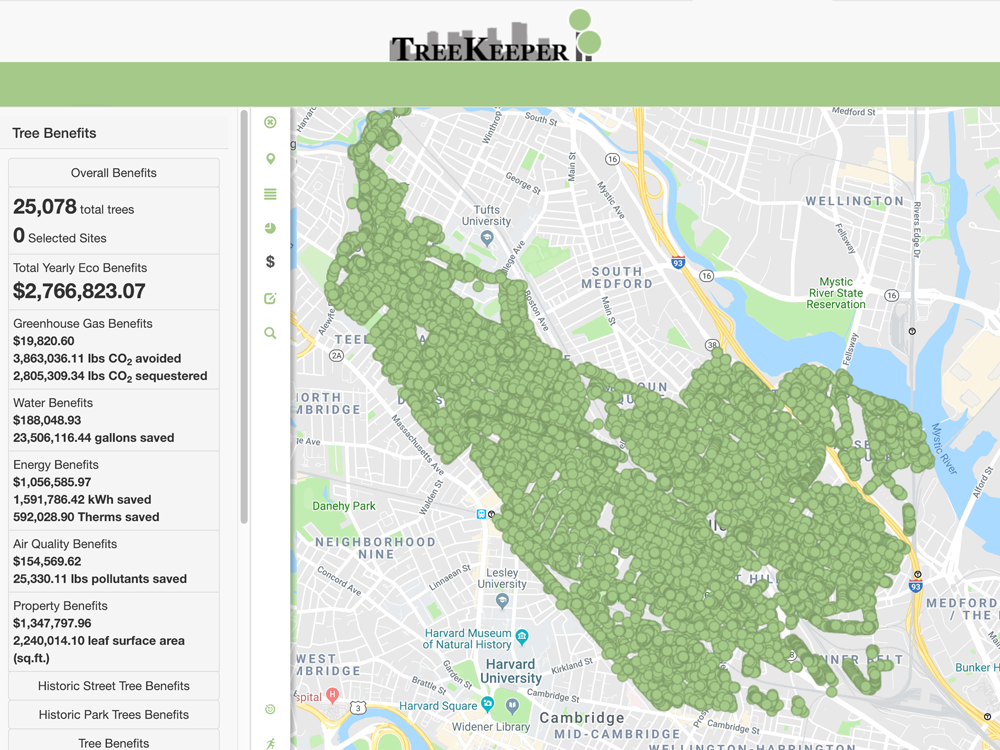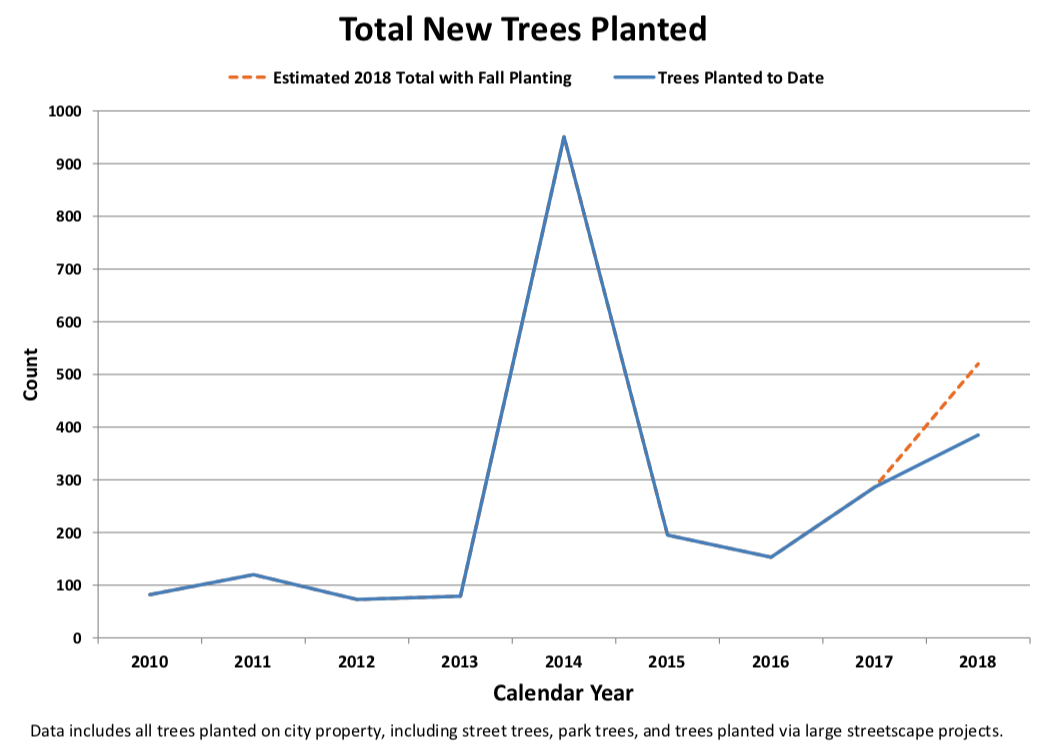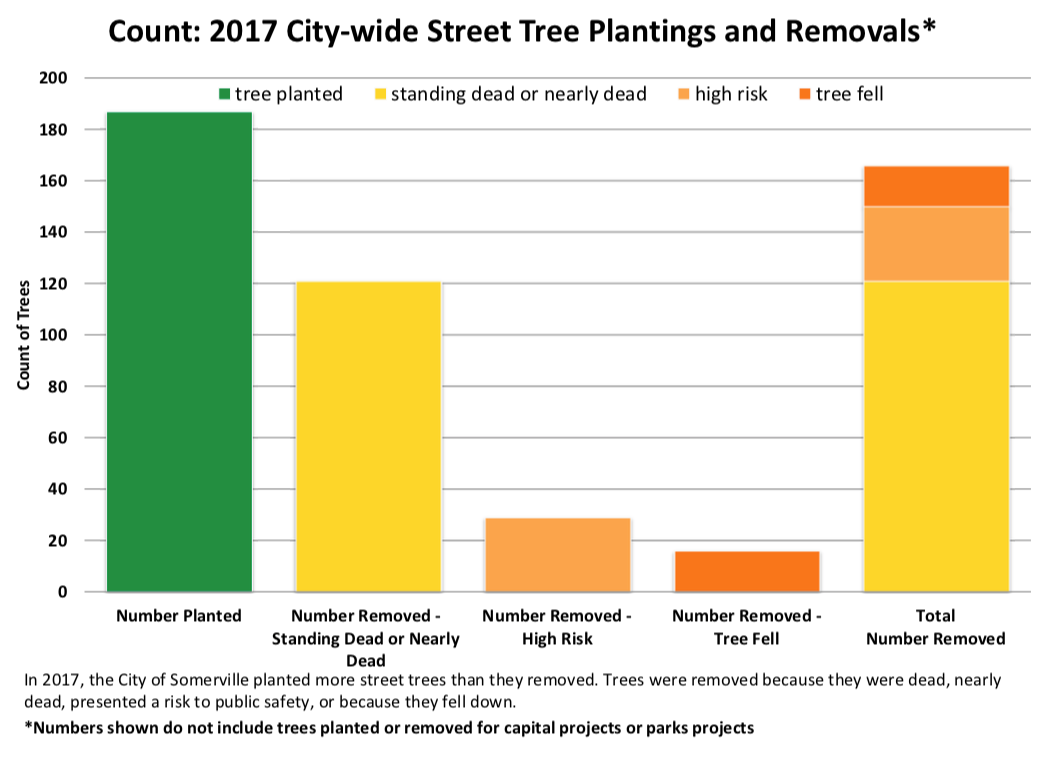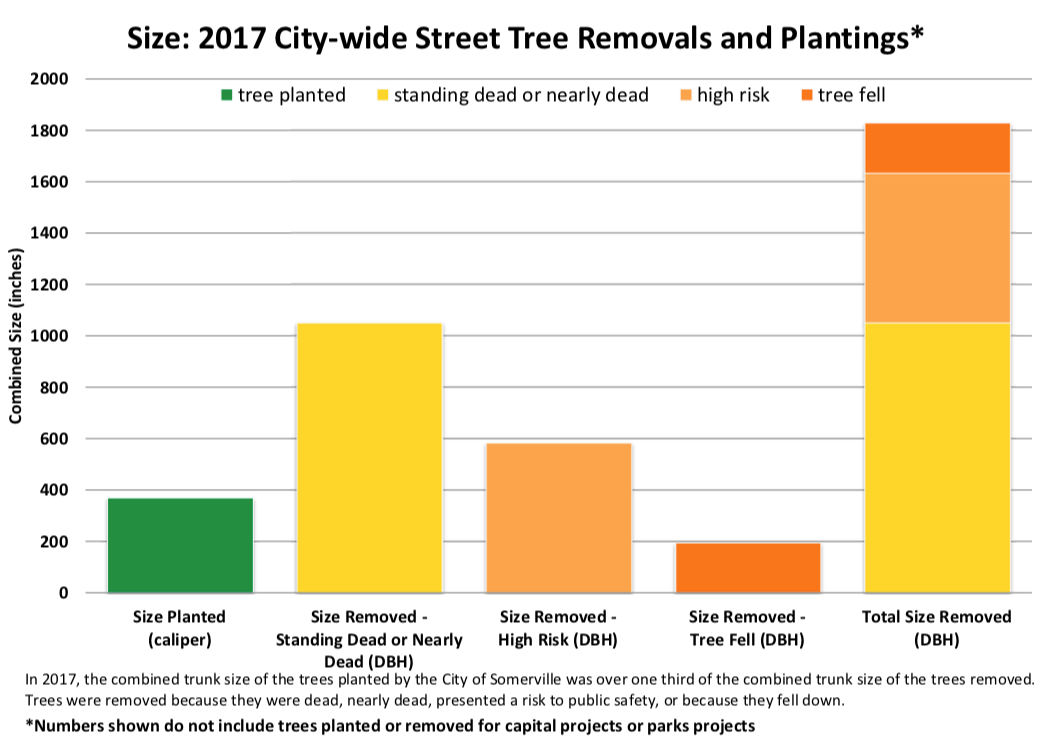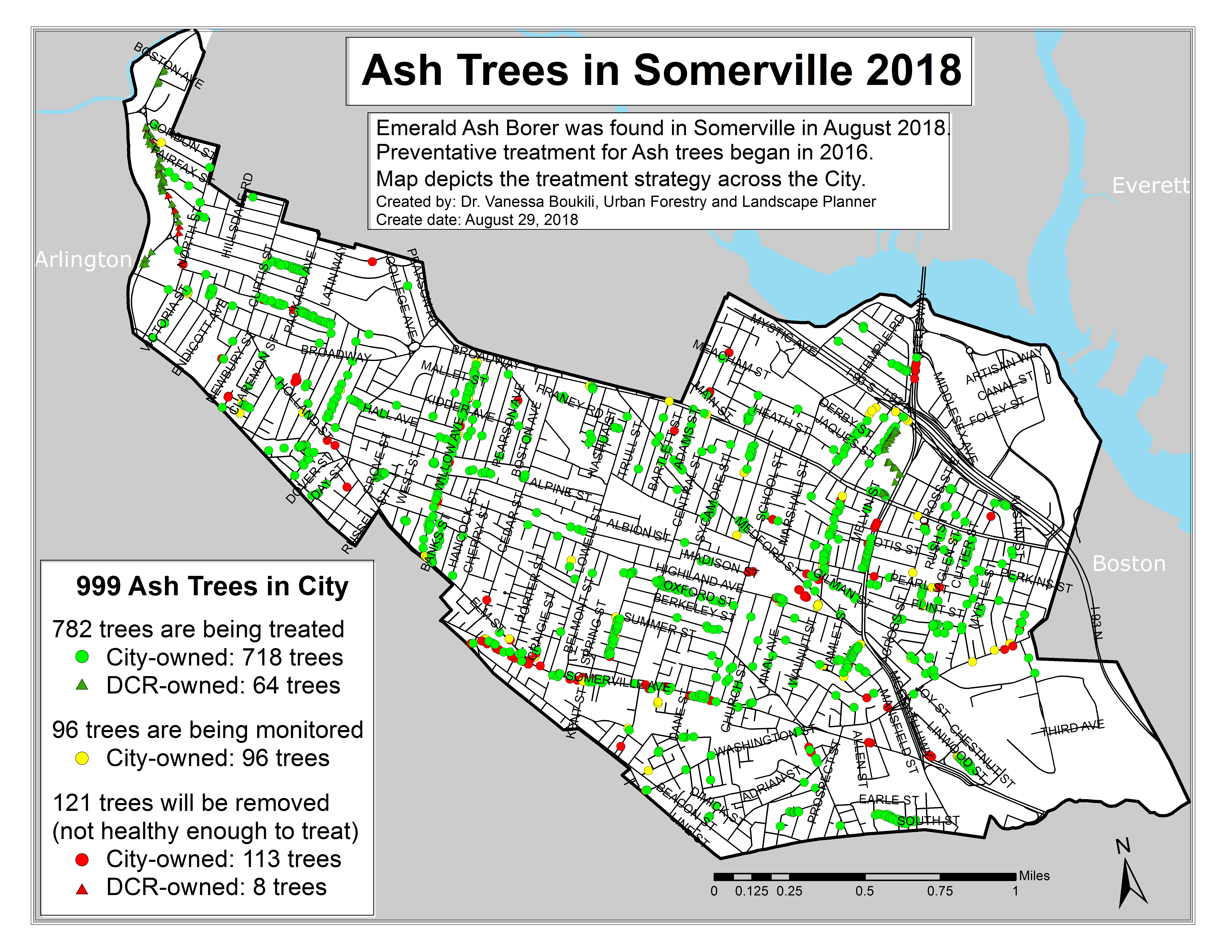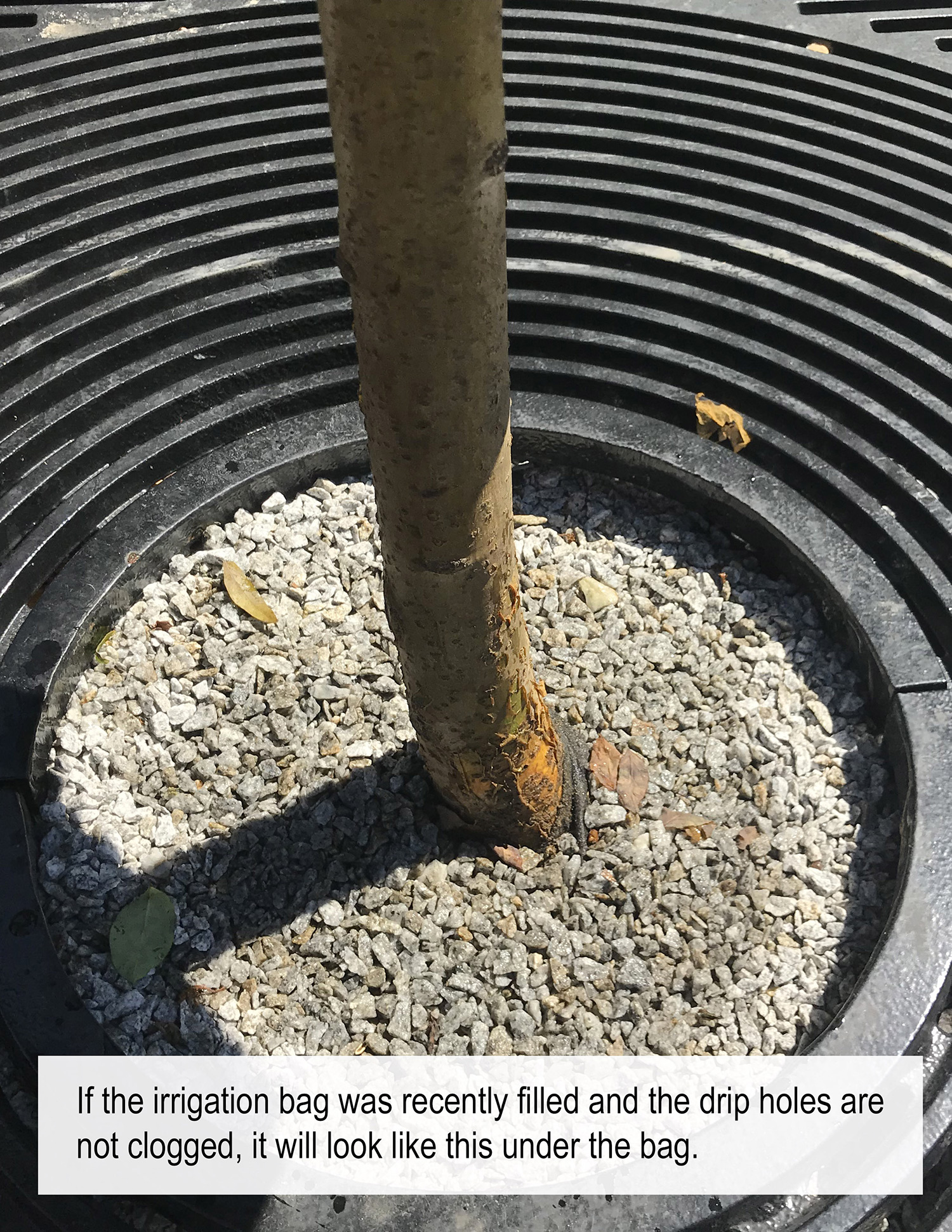About the Urban Forestry Division
The Urban Forestry Division manages, plans and cares for Somerville’s more than twelve thousand public trees. Somerville’s urban forest offers countless ecological, economic, and health benefits to the community. Trees remove carbon dioxide and harmful pollutants from the air, cool city temperatures, reduce storm-water runoff, all while increasing property values and beautifying urban landscapes.
Contact Information
Monday - Wednesday
8:30 a.m. - 4:30 p.m.
Thursday
8:30 a.m. - 7:30 p.m.
Friday
8:30 a.m. - 12:30 p.m.
93 Highland Ave.
Somerville, MA 02143
United States
Employee Directory
Jump To:
2025 Fall Tree Planting Map
The City of Somerville is planting 186 trees citywide this Fall. The map below shows details about the placement and species of these trees.
2025 Spring Tree Planting Map
The City of Somerville is planting at least 175 trees citywide this Spring. The map below shows details about the placement and species of some of these trees, and will be updated soon with the remaining locations.
2024 Fall Tree Planting Map
The City of Somerville planted 180 trees citywide this Fall. The map below shows details about the placement and species of these trees.
2024 Spring Tree Planting Map
The City of Somerville is planting approximately 290 trees citywide this Spring, including 94 in the Spring Hill Sewer Separation project area. The map below shows details about the placement and species of some of these trees, and will be updated soon with the remaining locations.
- Fall 2023 Tree Planting Map
-
The City of Somerville planted 182 trees during the Fall 2023 Planting Season. The map below shows details about the placement and species of these trees.
- Spring 2023 Tree Planting Map
-
The City of Somerville planted 185 trees during the Spring 2023 Planting Season. The map below shows details about the placement and species of these trees.
- Fall 2022 Tree Planting Map
-
The City of Somerville planted 195 trees during the Fall 2022 Planting Season. The map below shows details about the placement and species of these trees.
- Spring 2022 Tree Planting Map
-
The City of Somerville planted 157 trees during the Spring 2022 Planting Season. The map below shows details about the placement and species of these trees.
- Fall 2021 Tree Planting Map
-
The City of Somerville planted 270 trees during the Fall 2021 Planting Season. The map below shows details about the placement and species of these trees.
- Spring 2021 Tree Planting Map
-
The City of Somerville planted 80 trees during the Spring 2021 planting season. The map below shows details about the placement and species of these trees.
- Fall 2020 Tree Planting Map
-
The City of Somerville planted 140 trees during the Fall 2020 planting season. The map below shows details about the placement and species of these trees.
- Spring 2020 Tree Planting Map
-
The City of Somerville planted 65 trees during the Spring 2020 planting season. The map below shows details about the placement and species of these trees.
- Fall 2019 Tree Planting Map
-
The City of Somerville planted 151 trees during the Fall 2019 planting season. The map below shows details about the placement and species of these trees.
- Spring 2019 Tree Planting Map
-
The City of Somerville planted 145 trees during the Spring 2019 planting season. The map below shows details about the placement and species of these trees.
- Fall 2018 Tree Planting Map
-
The City of Somerville planted 88 trees during the Fall 2018 planting season. The map below shows details about the placement and species of these trees.
In 2017-2018 the City of Somerville created an inventory of all of the public trees in the city, including trees located along public streets, in public parks, and surrounding public buildings and other public spaces. This inventory was completed by arborists at Davey Resource Group and is being maintained by City staff in Davey’s TreeKeeper software here. The inventory shows information about the location, species, and size of each public tree, as well as the combined ecosystem service benefits provided by all of the trees. Additional data about trees or locations can be provided upon request.
You can explore parts of the map or groups of trees using the Map Tools and Search menu features located on the left-hand side of the Inventory Screen.
You can also explore our historical tree inventory data from 2009 by clicking on the Layers menu feature and selecting Historic Park Trees or Historic Street Trees.
Documents
-
City of Somerville Urban Forest Management Plan
-
Information About Prospect Hill Park Elm Tree Removal
-
Information About Symphony Park Beech Tree Removal
-
City of Somerville Recommended Street Tree Species Planting List
-
City of Cambridge Urban Forest Management Plan: Current State of the Urban Forest
-
City of Cambridge Urban Forest Management Plan: Scientific Analysis of Current Trends in Growth and Survival of Cambridge’s Street Trees and Management Recommendations
-
2018 Mass DCR Urban and Community Forestry Challenge Grant Application
-
October 2018 Public Hearing Background Slides
-
Native Species Ordinance Report FY2023
-
Native Species Ordinance Report FY2022
-
Native Species Ordinance Report FY2021
Videos
October 25, 2018 EAB Information Session (View Presentation Slides as PDF)
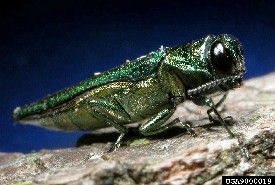 Officials with the Massachusetts Department of Conservation and Recreation (DCR) and the Department of Agricultural Resources (DAR) have confirmed that the Emerald Ash Borer (EAB) has been detected in 43 communities within eight counties in Massachusetts, and on August 17, 2018, DCR's Forest Health Program confirmed the presence of EAB in Somerville. The destructive beetle, which has been detected in 32 states, first appeared in the Commonwealth in the western town of Dalton in 2012. Since that time, the ash borer has been found in Berkshire, Essex, Hampden, Hampshire, Norfolk, Suffolk, and Worcester counties, as well as in multiple communities in Middlesex County where Somerville is located. To prevent its spread, the entire state of Massachusetts is now under ash borer quarantine, meaning that untreated firewood and other related materials (see below) may not be taken from the Commonwealth into any neighboring state. Officials have also urged all residents in Massachusetts to be alert for any sign of this invasive species.
Officials with the Massachusetts Department of Conservation and Recreation (DCR) and the Department of Agricultural Resources (DAR) have confirmed that the Emerald Ash Borer (EAB) has been detected in 43 communities within eight counties in Massachusetts, and on August 17, 2018, DCR's Forest Health Program confirmed the presence of EAB in Somerville. The destructive beetle, which has been detected in 32 states, first appeared in the Commonwealth in the western town of Dalton in 2012. Since that time, the ash borer has been found in Berkshire, Essex, Hampden, Hampshire, Norfolk, Suffolk, and Worcester counties, as well as in multiple communities in Middlesex County where Somerville is located. To prevent its spread, the entire state of Massachusetts is now under ash borer quarantine, meaning that untreated firewood and other related materials (see below) may not be taken from the Commonwealth into any neighboring state. Officials have also urged all residents in Massachusetts to be alert for any sign of this invasive species.
About Ash Borers
The EAB is a small, flying beetle, native to Asia. It was first discovered in North America in 2002, in the Detroit, Michigan area. Unlike other invasive beetles, the EAB can kill a tree fast, within just a few years, because it bores directly under the bark, where the tree's conductive system is. Since its discovery in North America, it has killed millions of ash trees and has caused billions of dollars in economic loss across the nation.
Ash Trees: Popular in New England & Somerville
Ash is a main component of the Northern Hardwood forest in Massachusetts and is a common species in the Berkshires. Ash is also a common street tree in eastern Massachusetts. The City of Somerville has approximately 1,000 public ash trees (100 of which are on State property), which represents roughly 8 percent of the more than 12,000 public trees currently in the city.
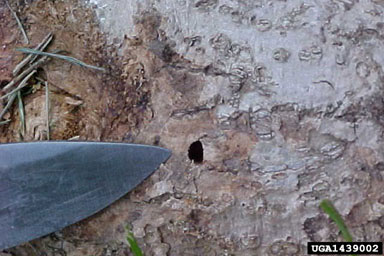 Signs of Ash Borers
Signs of Ash Borers
Residents are urged to take the time to learn the signs of EAB tree damage and be sure to report any sightings.
- Look for tiny, D-shaped exit holes in the bark of ash trees, die-back in the upper third of the tree canopy, and sprouting of branches just below this dead area.
- The Emerald ash borer is a small, emerald-green metallic beetle, so small that seven of them could fit on the head of a penny.
To report suspicious tree damage or insect sightings, or to learn more about this pest, visit www.massnrc.org/pests. You can also call the toll free EAB hotline at 1-866-322-4512.
More information about the Emerald Ash Borer can be found at in the EAB Guide on mass.gov and at http://emeraldashborer.info.
Stopping the Spread of Ash Borers at the State Level
DCR and DAR officials are working together, in collaboration with the United States Department of Agriculture's (USDA) Animal and Plant Health Inspection Service (APHIS) and the USDA's United States Forest Service to take a number of swift proactive steps aimed at preventing the spread of the invasive beetle, including trapping programs for early identification and the introduction of parasitic wasps known to prey on the ash borer and thus control their population. The state is also under quarantine.
Regulated items that fall under quarantine include the following:
- The Emerald ash borer, in any living stage of development;
- Firewood of all hardwood species;
- Nursery stock of the genus (Ash);
- Green lumber of the genus (Ash);
- Other material living, dead, cut, or fallen, including logs, stumps, roots, branches, and composted and uncomposted chips of the genus (Ash);
- Any other article, product, or means of conveyance that an inspector determines presents a risk of spreading EAB.
Ash Borer Prevention in Public Trees in Somerville
Along with other cities and towns in our region, the City of Somerville is taking preventive measures to stop the spread of ash borer in our area to avoid tree loss:
- Trapping: Ash borer traps (purple sticky traps) have been installed on select ash trees across the city for early detection of this pest. We will continue trapping to monitor the size and distribution of the EAB population.
- Preventive Treatment: As a preventive measure, healthy and fair condition trees are injected on a regular schedule with the organic insecticide TreeAzin, which can ward off ash borers. This treatment must be applied every two years.
- Tree Removal ONLY When Necessary: Unfortunately, sometimes trees are too sick to respond to treatment. In these cases, where absolutely necessary, dying and sick ash trees, which are more susceptible to infestation and can thus endanger nearby healthy ash trees, will be removed and replaced with other varieties of tree that thrive well in an urban environment.
Ash Trees on Private Property
Ash trees on private property are also susceptible to emerald ash borer. If you have an ash tree on your property, you should look for the signs of EAB listed above and consult with a certified arborist for recommendations and/or treatment. If the certified arborist determines that your ash tree needs to be treated or removed, please let the City know by emailing or calling 311. This allows the City arborist to collect data about where ash borers have been found and which trees have been treated.
- If you are not sure if your tree is an ash tree, this website can help you identify it.
Prevention of Ash Borer in Public Trees by the Numbers:
- ~878 Trees Being Treated and/or Monitored (including 64 State-owned trees)
- ~121 Require Removal and Replacement
Of Somerville's ~1,000 ash trees, 878 have been deemed to be in good or fair enough condition to benefit from preventive treatment with TreeAzin or to be in borderline poor condition warranting continued monitoring rather than removal. First-round injections for good-to-fair trees began in summer 2016 and will continue with regular boosters.
- Treated 2016 = 273 trees
- Treated 2017 = 410 trees
- Treated 2018 = 412 (including 265 trees that were initially treated in 2016, and 60 trees that were treated by DCR
Information Sessions and Hearings on Ash Borer Prevention Tree Removal/Replacement
Click on the links below to view materials from the City's past EAB hearings and information sessions.
October 25, 2018
May 2015, 2016
Tree Notices: Updated June 28, 2016
Removal of the City's seven dead ash trees commenced in summer 2016. Currently, the listing of vulnerable ash trees scheduled for PHASED removal as of June 2016 citywide is available for viewing. A phased removal of the City's sick and dying ash trees remaining on this list, as well as additional trees that have died or become sick in the interim, is ongoing. The updated list will be posted after additional seasonal review. Approximately 60 of the sick and dying ash trees on the list are expected to be removed in late fall 2018.
Why Do City Trees Get Sick?
There are many reasons that tree health can deteriorate in high-stress urban environments. These factors apply to all tree species as well as the ash tree and are among the factors that have contributed to the poor condition of the ~138 ash trees proposed for preventive removal/replacement:
- Inadequate oxygen or water intake due to compacted soils and impervious surfaces
- Soil chemistry changes, including impacts of road salt, dog waste or competing plant growth
- Poor air quality associated with vehicle emissions
- Heat stress on root systems due to asphalt and sidewalks heating up in the summer sun
- Physical injury due to vehicle collisions, storm damage, vandalism, etc.
Caring for Street Trees
Somerville is home to thousands of beloved publicly owned trees that offer countless benefits to the community: lowering urban temperatures, absorbing storm water, reducing air pollution, providing habitat, calming traffic, and so much more! Like all urban trees, Somerville trees face a number of challenges such as inadequate water and nutrient availability, small growing spaces, compacted soils, poor soil quality, vandalism, and other harmful human influences.
You can help. Become a Tree Steward.
1. Water
Watering is the most important thing you can do, especially for young trees.
- Young trees need 15-20 gallons of water (that’s 3-4 large buckets) per week between May and October.
- If there is a “gator bag” on the tree, it should be filled once a week. It is designed to slowly release water into the soil, so it will not always be full.
- If the tree does not have a gator bag, water slowly so that the water penetrates the soil and does not run off the surface. You can poke small holes in a large bucket and let it drain into the soil overnight.
- If the soil is compacted, carefully loosen the top 2-3 inches of soil to help water and air reach the roots. Do not dig deep into the soil and do not use large tools, as you could damage the tree’s roots.
- If it rains 1 inch or more in a week, you do not need to water the tree.
Click on the images below to enlarge them:
2. Protect
 Damage to the bark and wood creates wounds that compromise the health of a tree.
Damage to the bark and wood creates wounds that compromise the health of a tree.
- Do not lock bikes to trees.
- Do not put signs on trees with nails or tape.
- Do not break or rip off branches.
- Do not fertilize young trees. Most fertilizers promote canopy growth over root growth.
3. Weed
Weeds are fast growing and reproducing plants that take resources from our street trees. Remove weeds from tree wells as frequently as possible.
- Wear gloves when removing weeds.
- Make sure the plant you’re removing is a weed.
- Do not use a weed whacker or lawn mower in tree wells or near tree trunks, as these can damage the tree.
- Weed your site early in the fall before weeds dry out and disperse seeds.
- Take out the weed’s entire root system. Use a trowel to dig out stubborn roots.
4. Remove Trash and Waste
Tree pits are often receptacles for debris, litter, and waste that can be harmful to the tree’s health. Human and animal-derived waste can alter soil quality, damage exposed tree roots, and give the tree pit an unsightly appearance. Younger street trees are especially susceptible to this type of damage.
- Wear gloves when removing trash.
- Do not touch any hazardous or hazardous-looking materials (e.g., needles, toxic chemicals, dead animals). Call 311 if you find any.
- Keep dogs and dog waste (both liquid and solid) away from the tree. The waste will overwhelm a tree, burning its trunk and throwing soil nutrients out of balance. Remove all of your pet’s droppings (or those of any other animal) from the tree bed.
- Keep garbage and de-icing salt out of the tree pit. Try alternatives to rock salt (sodium chloride) such as calcium chloride, granular urea, sand, or sawdust. In the spring, flush the tree pit with water to dilute winter salt buildup.
- Pick up any discarded cigarette butts within tree pits. The inorganic material in cigarette filters will not decompose and the chemicals in the cigarette can damage the tree.
5. Planting Vegetation
Perennials, annuals, and bulbs are beautiful additions to a tree pit, as long as tree health comes first.
- Raising the tree pit soil level by more than 2 inches can smother tree roots and harm tree trunks, which reduces the lifespan of a tree.
- Do not plant flowers within 1-foot of the tree trunk.
- For plantings made at the existing soil level, use small plants and bulbs – large plants require large planting holes, which damage tree roots. In addition plants with large root systems compete with the tree for water and nutrients.
- Choose plants that require little watering. Keywords to look for are “drought tolerant” and “xeric conditions”.
- When watering your plants, be sure to provide enough water for the tree, not just enough to perk up the flowers.
- Mulching a tree pit with 2-3 inches of wood chips or shredded bark is good for your tree and plants. Mulch keeps the soil moist, insulates roots and prevents weeds from sprouting in tree pits. But it is important to keep all mulch at least 2 to 3 inches away from the trunk of the tree. Do NOT pile up the mulch around the trunk of the tree into “mulch volcano” because this can rot the bark and suffocate important structural roots.
6. Communicate with the City
Call 311 to:
- Request a new tree in front of your property.
- Request the removal of a dead tree. The City will not remove a healthy tree.
- Request that a tree is trimmed (pruned).
- Request that an arborist inspects the health of a tree.
- Report serious damage to a tree.
On June 27, 2019, the Somerville City Council passed a Tree Preservation Ordinance (Ord. #2019-15) with new requirements for the removal of trees on private property. The ordinance went into effect on August 1, 2019, and incorporates and updates the prior City of Somerville Tree Ordinance, which set requirements only for the removal of public trees.
Programs & Initiatives
Feedback
Please submit website feedback using this form. Be sure to include:
Thank you for your feedback!
